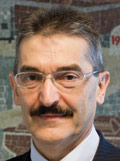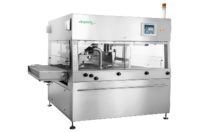In early July, Mitch Barns, ceo for Nielsen, a global consumer research company, participated in a panel at the Aspen Ideas Festival dealing with the topic, “Global trends that will affect us all.” In addressing the various cultural, political, demographic and technological shifts affecting our world, the panelists remained optimistic, despite acknowledging the real challenges and continuing regional crises.
When asked why, Barns explained in his blog that “Here is where the theme of innovation fueled by collaboration emerged… In the recent past, the world has collaborated to make significant and lasting strides in global health and poverty, succeeding by making these challenges an absolute priority. We — governments, business, NGOs, academia — need to band together again, as we did in taking on health and poverty, and take advantage of a time of substantial change to create an ecosystem that will move us towards a healthier society.
“Innovation does not, of course, mean throwing out the old for the sake of the new. Access to capital will be helped by microfinance and crowdsourcing, but traditional mechanisms such as large-scale, business-driven investment will also be necessary if we are to keep up and ideally keep ahead of the megatrends shaping the world right now. Similarly, the competition that creates healthy markets must be accompanied by the collaboration that can drive efficiencies where there would otherwise be duplication.
“This type of collaboration requires ‘non-zero sum’ thinking. It’s difficult. It requires confidence, trust and leadership. But it’s immensely important. Throughout history, it’s been the key to progress for entire markets, communities and nations. The same will be true of the years ahead.”
In that spirit, Candy Industry Magazine provides innovative insights from leading confectionery processing and packaging equipment suppliers. Those of us familiar with the confectionery industry recognize its uniqueness, a collegiality and solidarity seldom found in other competitive sectors. And yet, within confectionery, collaboration is most often the norm. And thus, so is innovation.
- Mads Hedstrøm, Aasted
- Thomas Bischof, Bühler AG
- Moreno Roncato, Carle & Montanari-OPM
- Frank Temme, Hänsel Processing GmbH
- Christian Werner, Hebenstreit
- Mirjam van Dijk, Royal Duyvis Wiener B.V.
- Ralf Schäffer, Sollich KG
- Markus Rustler, Theegarten-Pactec
- Rainer Runkel, Winkler und Dünnebier
Mads Hedstrøm, chief sales officer
Aasted: Cutting edge technology and Danish high quality

Aasted, a consolidated, Danish, family-owned company, always has been driven by a passion for innovation.
Ongoing innovation, new developments and expansion is maintaining Aasted’s position as a world-class supplier within the chocolate, bakery and confectionery industries.
In our Technology Center, the customer’s imagination is the limit!
Aasted is committed to developing new inventions, but also committed to continuously improving its Technology Center. Here, Aasted’s customers as well as technicians have the opportunity to test and develop products on an industrial scale.
The Technology Center boasts years of shared experience, and is built upon three keywords:
- Innovation
- No Limitations
- Experience
Through innovative thinking we wish to keep developing new technology and machinery for our customers — as evidenced by our energy concept. It’s not just “going green” innovation, but the desire to produce better quality chocolate.
Aasted’s groundbreaking Energy Tempering Technology is the future trendsetting standard for tempering technology. With the SuperNova Energy Temperer, time and shear are essential to create the many small stable Beta 5 crystals that allow dense crystal structures to form for slower fat migration.
Furthermore, the machine fully tempers one-third of the mass by allotting extra time and shear and then re-circulating that mass to the remaining two-thirds. The Energy Enrober operates by direct injections of the tempered chocolate mass from the tempering machine to the consumption flow. As a result, Aasted ensures homogeneous tempered mass as well as a constant tempering index and temperature in the enrober.
When the SuperNova Energy Temperer is used in tandem with the Energy Enrober, the results are unmistakable: Not only have we seen savings ranging between 50 to 80 percent when compared to traditional tempering and enrobing units, but we’re even producing better chocolate with higher gloss and a crispier break.
We continuously work on refinement. Our goal is always to develop products beyond expectation, and to provide solutions which our customers will find indispensable.
Thomas Bischof, marketing director - chocolate, cocoa and coffee
Bühler AG: Innovations for a better world

Every three years, interpack provides the opportunity for Bühler to affirm its position as a leader in the industry as well as showcase our latest innovations. This year, we proudly displayed the latest developments, products and technology solutions — all 11 of them — within a 1,200-sq.-meter area. Moreover, many of Bühler’s innovations set trends for entire branches, opening up completely new horizons for the manufacture of confectionery products.
For example, in cocoa, Bühler introduced its latest development in cocoa roasting, the Barth Tornado RSX. A new technology enables higher productivity, efficiency and flexibility in the roasting process. The shorter cycle times per batch boost throughput of alkalized nibs by an average of 20 percent. With the PreGrind beater blade mill and FineGrind bead mill, Bühler underscored its competence in cocoa grinding. In addition, the WinCos control system opened up new dimensions in cocoa plant control.
Visitors looking for manufacturing systems for cocoa or chocolate were able to review Bühler’s broad “bean-to-bar” chocolate processing portfolio, which offers excellent process solutions for any and every vision — from single machines to entire production plants.
Those interested in smaller volumes were also rewarded, with Bühler introducing new compact solutions for lower capacities via its MicroFactory. The concept addresses the needs of small and mid-size producers. In addition, it provides the perfect approach to enter new markets with a minimum investment.
Bühler also sets the standard in chocolate processing with its DoMiReCo process (Dosing-Mixing-Refining-Conching), clearly demonstrating its ability to innovate within this processing chain.
As for hygienic design, the stainless steel ShearMix represents only one of many pieces of equipment that demonstrate how Bühler has embraced the concept to facilitate maintenance and sanitation.
The five-roll refiner Finer S, which is also available in stainless steel for improved hygiene, is now equipped with a new cooling system and drive concept for reducing energy consumption. A new drive concept for reducing energy consumption will also be shown for the new Frisse ELK single-shaft conche.
In chocolate moulding, Bühler unveiled its “Compact” series, the ChocoMaster Compact. The ChocoMaster Compact is a chain conveyor moulding line for mid-range capacities (500–2,500 kg/h) of solid- and one-shot filled chocolate products. To complement the moulding line, Bühler exhibited a PowerShot depositor and a CoolCore cold stamping unit, suitable for a production speed of up to 32 moulds per minute.
Moreno Roncato, chief executive officer
Carle & Montanari-OPM: Innovation — an ongoing commitment

For Carle & Montanari-OPM, “The tradition of innovation” isn’t only a marketing payoff. It is, first of all, a commitment that we have chosen to follow continuously.
Innovating means developing new products and improving existing ones to better match customers’ expectations, in terms of reliability, efficiency and savings.
So, only a few months after having introduced the automatic fineness control system MicronSense, our Process R&D department has developed an energy-saving system for the HFI five-roll refiner.
Thanks to an advanced application of inverters to drive the two main motors of the machine, this new development allows to save energy re-using the brake power generated by the first roller motor during normal operations.
At the last interpack, we also presented news about our moulding equipment, introducing the new depositor AERO CORE, based on the patent-pending Always In-Line Piston (AILP) technology.
The AERO CORE is a special version of the CORE, the successful depositor engineered by CM-OPM a few years ago — completely removable, modular and electronically driven — whose dosing groups are assembled on sliding guides for easy removal for cleaning and replacement.
The AERO CORE is especially suitable for dosing aerated pressurized masses. In fact, the design uses the AILP concept to eliminate pressure drops caused by changes of direction of material flow.
But in CM-OPM we are also innovating by introducing and enhancing services to better support customers.
This is the reason why we have strengthened our After Sales area, introducing a new Customer Service Direct Line, which represents the best way to communicate with this department. It consists of 15 people working in two specific areas, one dedicated to processing and moulding lines and the other one focused on packaging lines.
Frank Temme, co-owner and co-managing director
Hänsel Processing GmbH: Close customer partnership leads to innovative developments

Hänsel Processing GmbH is known worldwide for its outstanding experience and expertise in supplying high quality and innovative confectionery processing equipment.
We constantly strive to keep up with the customers’ most up-to-date demands and that is why we dedicate a huge amount of time and money to R&D.
A brand new development from Hänsel is the aerating machine TURBOMAT. For several years we included aerating machines from other suppliers, but due to strategic reasons and with the knowledge and experience of many years and projects, we are now able to provide our own aerating machines.
Our close working relationships with customers, particularly in listening to and addressing their demands, also allows us to address the topic of sustainability, which is becoming more and more important in the worldwide confectionery industry market.
In addition, our traditional and at the same time highly innovative and economical machines are designed for maximum productivity. What counts are short changeover times, long maintenance intervals and uncomplicated, fast customer service.
A user-friendly design guarantees continuous high outputs even after a short period of vocational adjustment, not only for high-quality hard candies (center-filled, aerated, laminated, milky, sugar-free, medicated, specialities), but also for all kinds of other sugar products, jellies and fondants (gelatin, agar agar, pectin, gum Arabic, starch, fondant crème, bakery fondant, milk fondant, fruit fondant), toffees (milk caramel, éclair, fruit candies, chewy candies, caramel layers, specialities) and bars (foam sugar, candy bars, granola, torrone, halwa).
When it comes to gums and jellies, we had a breakthrough with regards to producing the best products, even nutritional confections. The JellyStar cooking plant, appropriate for all common jellying agents, is characterized by a compact design, offering the possibility to produce high quality aerated and transparent jellies with HPG machines, even if space is limited. The JellyStar cooker can be integrated in existing plants, too.
The products are processed extremely carefully in this cooker with low vapor pressure and short residence time. By means of the JellyStar, nutritional gums and jellies (including temperature-sensitive, natural/nutritional additives) can be manufactured with very high dosing preciseness and lowest thermic force.
Christian Werner, general sales director
Hebenstreit: Innovations supported by a personal touch

Hebenstreit is recognized worldwide as the manufacturer of state-of-the-art wafer production lines for flat and hollow wafers. Its wafer production lines, which range from medium to high capacity outputs, are all designed and manufactured in Germany.
Owing to its medium size, Hebenstreit can still support its customers with a special personal touch. The company is constantly improving its technology, and, as a result of such, the output of its wafer machines has recently been increased significantly.
In the early 1980s Hebenstreit launched the plate size of 700 x 350 mm, which is today´s standard. Now they are presenting the next step — 1,000 x 350 mm, the largest size ever and representing the highest capacity on minimum floor space!
Wafer baking plates needs to be cleaned periodically. The frequency depends mainly on the batter ingredients and usually varies between once a month and once a year. Doing this with the traditional caustic soda method is a very time-consuming job and the process creates various difficulties.
Hebenstreit has now developed a fully automatic cleaning technology. A robotic handling system is adapted to the rear side of the baking machine. This automated system handles the opening and closing of the baking plate carriers so that the cleaning process can be carried out. Various cleaning methods such as laser, dry ice pellets, can be used for the cleaning process.
Using proven laser technology powered by the German expert SLCR provides the most benefits and the most efficient way of cleaning. In addition to cleaning the baking plate surface, Hebenstreit’s technology is also able to clean the vent strips, which are very significant for the baking process.
The system is designed to provide the highest flexibility so that only one handling system with the laser unit can be adapted to several Hebenstreit baking machines. Once each baking machine has been prepared for the docking process, the baking plates and vent strips can be cleaned in a minimum time and at lowest cost.
In order to operate any production line with high efficiency, batter quality and consistency is very important. Therefore, Hebenstreit has updated the proven “TECON mixing technology.” These modular batter mixing systems include raw material handling systems, feeding and dosing systems and the mixing technology itself. By further automating the process, batter is supplied to the baking machines at the highest level of quality.
Having all this in mind, it is obvious that many of the worldwide popular wafer products are made with Hebenstreit’s technology and support. As we say, “Your requirement – Our challenge. Technologies for your success.”
Mirjam van Dijk, managing director
Royal Duyvis Wiener B.V.: One-stop-shopping from bean to bar!

Royal Duyvis Wiener has again strengthened its position in the cocoa and chocolate processing industry.
After the successful addition of Thouet GmbH last year, Royal Duyvis Wiener is proud to present our newest group member: the company JAF Inox, located in Tambau, Brazil.
The portfolio of JAF Inox provides a perfect complement to Royal Duyvis Wiener, as it focuses on gourmet “bean to bar” chocolate processing as well as laboratory size chocolate equipment.
JAF Inox, being one of the leading manufacturers of gourmet “bean-to-bar” and laboratory size cocoa and chocolate equipment, supplies and services multinational companies, artisanal chocolate makers, universities, technology centers and research institutes. As a result, this provides a great value to the Royal Duyvis Wiener group.
JAF Inox can supply complete turnkey chocolate production systems from bean to bar. The standard lines are economical ranging in capacity from 2½ up to 200 kilos of chocolate per hour. The assortment of equipment ranges from bean cleaning, roasting, winnowing and grinding to five-roll refining, conching, tempering, moulding and enrobing.
The Royal Duyvis Wiener group has taken an additional important step in the globalization of the company with this move, as it brings us even closer to our customers. We will now be able to serve and support our South American customers from our new location in Brazil with the high quality standards all have come to expect.
Our dedicated staff all around the globe is looking forward to translating your challenges in cocoa and chocolate processing into sustainable solutions.
Royal Duyvis Wiener: your reliable travel partner on the path from cocoa bean to chocolate!
Ralf Schäffer, executive vice president,
Sollich KG: Innovation begins with the customer’s finished product

Sollich KG represents innovative and comprehensive solutions for chocolate and confectionery production. The product range covers equipment for most chocolate, confectionery, snack and bakery applications including enrobing, tempering, cooling, bar and praline center-forming.
The machines are designed and built by well-trained engineers and technicians — individually tailored to customers’ requirements. The timely and flexible production as well as the reliability and long service life of the machines are the hallmarks of Sollich systems.
One highlight from Sollich’s vast range of processing equipment involves the Turbotemper Top tempering machines in various sizes and executions. Together with the automatic Tempergraph for continuous quality control, the Turbotemper Top series provides optimum tempering technology with best tempering results. The on-going development of the Flex Temper and its cleaning device allows optimum use of the machine adapted to the requirements of consumption when using different chocolate and filling masses. Therefore, oversized tempering machines and high energy consumption are history. In combination with these tempering systems various sieving, mixing and flavor dosing systems are completing the program.
The extended capacity range of the Reworktemper with capacities of 125 kg/h (new), 250 kg/h and 400 kg/h, guarantees exact traceability of the raw materials due to direct processing of the rework (chocolate with ingredients like nuts and raisins, etc.). With the RWT 125, Sollich offers an economic and efficient solution to operators of smaller moulding lines.
The newly developed enrobing lines type Sollcoater SC and SCT, which have working widths of between 520 and 820 mm, as well as the Conbar line and Sollcocap lines, show that the company is investing significant resources and effort into its R&D center to continuously optimize the equipment. Besides innovations to improve the processing technology, Sollich’s R&D department focuses on ongoing improvements in energy saving, hygiene and overall efficiency of the production lines.
Sollich combines machine and processing know-how with an “innovative view into the future.” The company does not build a machine for the purpose of running a machine; rather it builds a machine to produce a finished product.
Thus, innovation at Sollich is not about solving a problem by adding or changing a component; innovation at Sollich begins with the finished product for our customers. The company then evaluates the processing steps and necessary components to tailor-make the equipment to address the client’s needs.
Markus Rustler, president
Theegarten-Pactec: Innovations for all performance levels

Theegarten-Pactec, the packaging machinery manufacturer from Dresden has the declared aim to offer a complete selection of wrapping styles and performance levels for small-sized confectionery items. In order to meet this aim, the mid-sized family company has come a long way based on many decades of experience and the know-how of more than 10,000 machines supplied.
The manufacturing program is organized into a matrix that comprises more than 30 individual solutions, for the three main product categories: hard candy and pre-formed products; soft and hard caramels, chewing gum and bubble gum (cut & wrap method); and chocolate. Several additional food and non-food applications are also available.
In each of these categories the typical wrapping styles can be offered. In co-operation with its customers, the company develops new designs and solutions to either optimize wrapping material use or to provide innovative solutions for the presentation at the point of sale.
One of the key competences of Theegarten-Pactec has been the development of continuous-motion, high-speed machines. The EK4 is the world’s No. 1 twist wrapper for high-boiled sweets reaching an output of 2,300 candies per minute. For hard and soft caramels, chewy sweets, chewing gum and bubble gum, the machine types WHF (fold wrap) and WHD (twist wrap), again are unmatched on the market with outputs of 1,800 pieces per minute.
However, Theegarten-Pactec also continues to invest in the low-speed area (up to 500 pieces per minute) in view of the fact that high-speed solutions are not suitable for every market and every manufacturer. Highest priority is given to a wide range of products in order to cover all output requirements.
With the models MCC (for chocolate) and, (for high-boiled sweets as well as delicate products such as jelly) a modular concept has been created to offer more flexibility for the medium-sized manufacturer. These machines allow an uncomplicated change of product sizes and wrapping styles without excessive down-times.
Theegarten-Pactec’s innovations originate through its research and development departments, the company’s creative center. Out of a total of about 380 staff members, more than 80 work in these departments. The same individuals are also in charge of concrete customer requirements, such as the integration of individual packing machines by appropriate feeding, separating and collecting systems to form complex packaging lines.
The latest developments were recently displayed at interpack in May 2014. In total, the company showcased twelve exhibits and twenty types of packaging at the world’s leading trade fair for this sector.
The HCW4/FPC5 attracted a great deal of attention: This new generation of machines offers several new features for packaging high-boiled sweets in bottom-fold packaging and further packaging into stick packs. The machine features a new unit which groups individual products for secondary packaging and completes any product formation. Defective products are rejected without affecting the grouping operation. The grouping unit buffers any empty cycles until the right number of products for transferring to the secondary wrapping machine has been reached.
Moreover, Theegarten-Pactec presented another innovation with the updated CWM2. The packaging machine for chocolate products boasts significantly improved ergonomics and accessibility for users compared to its predecessor. Wrapping styles and formats can now be changed in no time at all and can also be easily reproduced.
Then there is the MCC, which is the first continuous-operation machine to offer Vienna-fruit fold wrapping, was also on display. This increases the maximum operating speed for this type of wrapping from 400 to 800 products per minute. The MCC is a continuous motion wrapping machine in the medium speed range with belt or chain feeding for chocolate products in various wrapping styles.
Rainer Runkel, managing director
Winkler und Dünnebier: Unlimited variety with WDS

Winkler und Dünnebier Süßwarenmaschinen GmbH (WDS) is one of the world’s leading manufacturers of confectionery production machines. With its comprehensive machinery and production portfolio, WDS has the capability to cover the whole spectrum of deposited confectionery products within various application and capacity ranges. WDS production lines have a reputation for the highest quality and reliability throughout the whole world. Moreover, the company is always putting a special focus on hygiene-oriented machinery executions and the possibility to carry out mass changes quickly and comfortably. All WDS moulding lines are modularly designed in order to provide highest flexibility.
A special technical feature that carries a lot of advantages in practice is the so-called Easy Clean execution. All parts that need to be cleaned, such as the depositing plate, the depositing unit and even the whole pump system, can be easily and quickly disassembled and then moved with a service cart to the washing or cleaning area. Thereby a depositing system can be exchanged in less than 15 minutes without unnecessary long interruptions of production.
WDS mogul lines are customized for manufacturing all starch-moulded products, such as jelly and gum (on pectin basis, gum Arabic, gelatin, agar-agar, carrageenan), as well as licorice, fondant, cream, marshmallow foam and similar items. The equipment is also suitable for depositing liquor.
All the systems use programmable single servo-electrical drives and are low maintenance, as well as offering easy operation and easy access for cleaning. They can be supplied with starch conditioning equipment, a cooling tunnel and subsequent oiling or sugar-sanding processes.
The company’s well known power of innovation always results in new solutions for confectionery production’s day-to-day needs.





